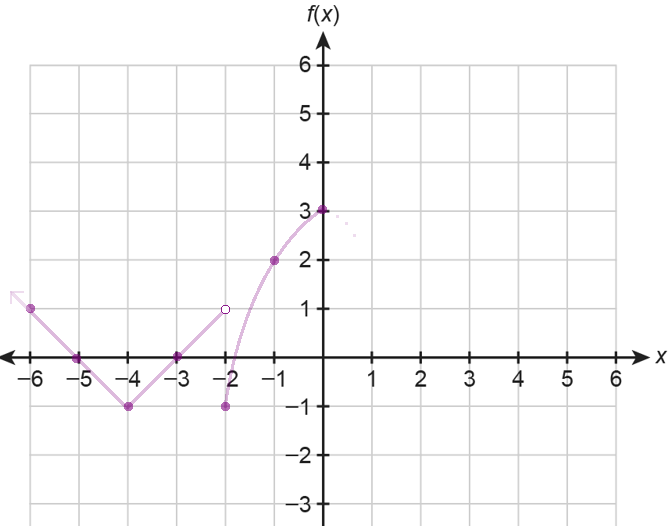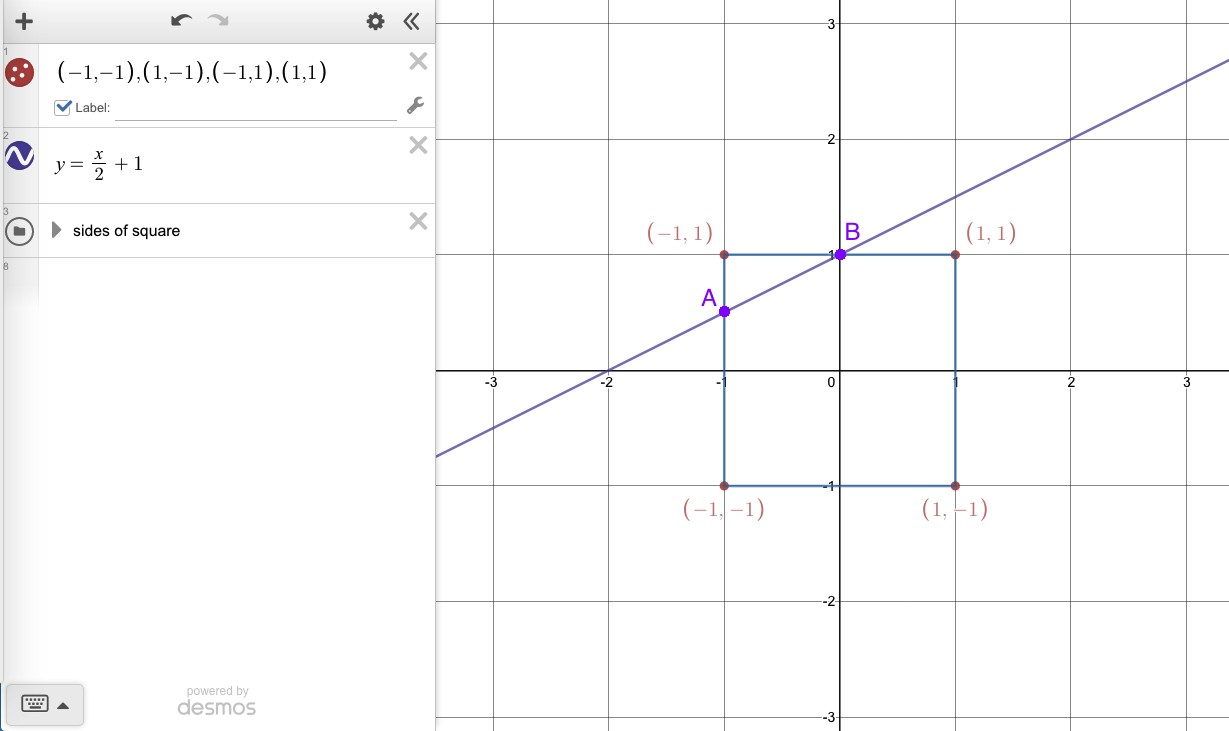We can graph y = f(x) by picking x values and plotting points.
| If x = -6, y = |x + 4| - 1 = |-6 + 4| - 1 = |-2| - 1 = 2 - 1 = 1 so (-6, 1) is on the graph. | |
| If x = -5, y = |x + 4| - 1 = |-5 + 4| - 1 = |-1| - 1 = 1 - 1 = 0 so (-5, 0) is on the graph. |
|
| If x = -4, y = |x + 4| - 1 = |-4 + 4| - 1 = |0| - 1 = 0 - 1 = -1 so (-4, -1) is on the graph. | |
| If x = -3, y = |x + 4| - 1 = |-3 + 4| - 1 = |1| - 1 = 1 - 1 = 0 so (-3, 0) is on the graph. |
|
| If x = -2, y = -x2 + 3 = -(-2)2 + 3 = -4 + 3 = -1 so (-2, -1) is on the graph. | |
| If x = -1, y = -x2 + 3 = -(-1)2 + 3 = -1 + 3 = 2 so (-1, 2) is on the graph. |
|
| If x = 0, y = -x2 + 3 = -( 0 )2 + 3 = 0 + 3 = 3 so (0, 3) is on the graph. | |
| As we plot the points, we can see what is happening... |
|
| First we just graph f(x) = |x + 4| - 1 but we only plot the points that have an x value less than -2 |
|
| Second we just graph f(x) = -x2 + 3 but we only plot the points with an x value in the interval [-2, 3) |
|
| And third we would graph f(x) = x but only plot the points with an x value greater than or equal to 3 |
|
| So far, these are the points we have: |
|

Notice that the point (-2, 1) is NOT on the graph and the point (-2, -1) IS on the graph.
Do you understand this so far? Do you see how to finish it? If you're still confused please say so!
Let's say a is the odd one and b is the even one. Then we can say...
a = 2b - 7 and b = 3a - 9
| So we can substitute 3a - 9 in for b to find a: | |
| a = 2b - 7 |
|
| a = 2(3a - 9) - 7 |
|
| a = 6a - 18 - 7 |
|
| a = 6a - 25 |
|
| -5a = -25 |
|
| a = 5 |
|
|
Now we can substitute 5 in for a to find b: |
|
| b = 3a - 9 |
|
| b = 3(5) - 9 | |
| b = 15 - 9 |
|
| b = 6 |
And...
a + b = 5 + 6 = 11

area of pentagon = area of square - area of triangle
area of square = (side length)2 = 22 = 4
To find the area of the triangle, we need to find the coordinates of A and B .
To find point A , we need to find the y-coordinate of the line when x = -1 .
\(y\ =\ \frac{x}{2}+1\\~\\y\ =\ \frac{-1}{2}+1\\~\\y\ =\ \frac12\)
So A = (-1, \(\frac12\))
To find point B , we need to find the x-coordinate of the line when y = 1 .
\(y\ =\ \frac{x}{2}+1\\~\\ 1\ =\ \frac{x}{2}+1\\~\\ 0\ =\ \frac{x}{2}\\~\\ 0\ =\ x\)
So B = (0, 1)
base of triangle = 0 - -1 = 1
height of triangle = 1 - \(\frac12\) = \(\frac12\)
area of triangle = \(\frac12\)( base )( height ) = \(\frac12\)( 1 )( \(\frac12\) ) = \(\frac14\)
Now we can find the area of the pentagon.
area of pentagon = area of square - area of triangle = 4 - \(\frac14\) = 3.75
Here's the graph: https://www.desmos.com/calculator/prypeui4fb